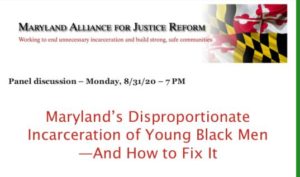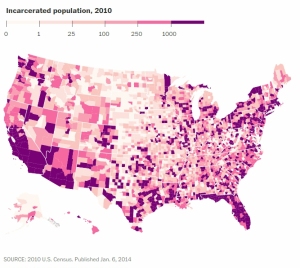![]() Relevant Facebook Posts on this topic.
Relevant Facebook Posts on this topic.
Prince George’s County Panel discussion:
Maryland’s Disproportionate Incarceration of Young Black Men – And How to Fix It.

That panel discussion has been recorded. Listen here. (1:56:21)
Or listen to the highlights here. (19:31)
Rethinking Approaches to Over-Incarceration of Black Young Adults in Maryland
Justice Policy Institute.
Punitive sentencing policies and restrictive parole release practices in
Maryland have resulted in a deeply racially disproportionate criminal
justice system that is acutely impacting those serving the longest prison
terms. This is true despite a declining prison population and state leadership
in Maryland having undertaken criminal justice reform in recent years. As
recently as July 2018, more than 70 percent of Maryland’s prison population
was black, compared to 31 percent of the state population.
For the full Justice Policy Institute report click here.
Job Opportunities Task Force Report:
The Criminalization of Poverty
The Job Opportunities Task Force has released a report on titled “The Criminalization of Poverty: How to Break the Cycle through Policy Reform in Maryland”.
… Given growing national attention and local concern around the impact of incarceration on working families, the Job Opportunities Task Force sought to define and determine the extent to which the criminalization of poverty is occurring in Maryland.
Justice Policy Institute Report:
BALTIMORE BEHIND BARS:
How to Reduce the Jail Population, Save Money and Improve Public Safety
After almost a year of conducting interviews, touring facilities and analyzing data, the Justice Policy Institute completed Baltimore Behind Bars, a report on the Baltimore criminal justice system, its state-run jail and the reasons for the jail’s overpopulation.
…This over-incarceration costs Maryland taxpayers too much money and has a negative impact on the Baltimore community,which already has the shameful distinction of having the largest percentage of its population in jail of any of the 20 largest jail jurisdictions in the nation.All of the criminal justice agencies operating in Baltimore contribute to this problem, and all of them can play a role in the solution.
VERA Institute Report.
The Prison Paradox: More Incarceration Will Not Make Us Safer describes research showing how the effect of incarceration as a deterrent to crime is minimal at best, and has been diminishing for several years—and how increased rates of incarceration have no demonstrated effect on violent crime and in some instances may increase crime.
Transforming Prisons, Restoring Lives: Final Recommendations of the Charles Colson Task Force on Federal Corrections
“After decades of unbridled growth in its prison population, the United States faces a defining moment. There is broad, bipartisan agreement that the costs of incarceration have far outweighed the benefits, and that our country has largely failed to meet the goals of a well-functioning justice system: to enhance public safety, to prevent future victimization, and to rehabilitate those who have engaged in criminal acts. Indeed, a growing body of evidence suggests that our over-reliance on incarceration may in fact undermine efforts to keep the public safe. Momentum is strong for a new direction, for a criminal justice system guided by proven, cost-effective strategies that reduce crime and restore lives.” See the full report.
The Safe, Accountable, Fair, and Effective (SAFE) Justice Act of 2015 (H.R. 2944) takes a broad-based approach to improving the federal sentencing and corrections system, from front-end sentencing reform to back-end release policies. It is also the first bill that addresses the federal supervision system – ensuring that probation does a better job stopping the revolving door at federal prisons. The legislation, which is inspired by the successes of states across the country, will reduce recidivism, concentrate prison space on violent and career criminals, increase the use of evidence-based alternatives to incarceration, curtail over-criminalization, reduce crime, and save money. See the quick two page summary.
Private Companies Profit from America’s Criminal Justice System. Today, private companies hold contracts that allow them to profit from all corners of America’s criminal justice system. Consequently, many people charged with crimes are exposed to the profit-seeking of companies every step of the way, from entering the system to being released. See these informative graphics.
Join AFSC and other Quakers working to end mass incarceration. The American Friends Service Committee works to end mass incarceration, improve conditions for people who are in prison, stop prison privatization, and promote a reconciliation and healing approach to criminal justice issues. Here is the AFSC Acting in Faith page.
The economic case for fixing mass incarceration. Start by holding prosecutors responsible for its enormous costs and giving them options for how to spend the funds they have. Read this essay in Slate.
Charles G. Koch, one of the most conservative voices in America, wrote an essay on “The Overcriminalization of America: How to reduce poverty and improve race relations by rethinking our justice system.” The article outlines a five-step approach to criminal justice reform.
What drives mass incarceration? In 2014, the National Academy of Sciences issued a major report: The Growth of Incarceration in the United States: Exploring Causes and Consequences.
Is U.S. justice really blind? Or just us? Michelle Alexander’s 2012 book, The New Jim Crow: Mass Incarceration in the Age of Colorblindedness, has sparked a national conversation about the fact that the “War on Drugs” has unfairly targeted communities of color, in particular young black men from poor communities. Find a study guide here and read it with others in your church or community.
Safely reducing prison populations. The Justice Policy Institute shows how to The Justice Policy Institute shows how to safely reduce prison populations.
The American Legislative Exchange Council (ALEC), a conservative advisory group, is concerned about prison overcrowding. They propose solutions that include alternatives to incarceration and promote rehabilitation and treatment programs.
The Washington Post has a recent article by Christopher Ingraham on Mass Incarceration. The U.S. has more jails than colleges. Here’s an interactive map of where those prisoners live.















